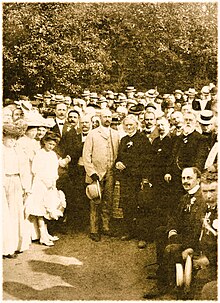German colonial society
| German Colonial Society (DKG) | |
|---|---|
| legal form | |
| founding | December 19, 1887 |
| resolution | 1933 |
| Reason for dissolution | in Reichskolonialbund risen |
| Seat |
Berlin , German Empire |
| management | see presidents |
| Branch | Colonial society |
The German Colonial Society (DKG) was formed on December 19, 1887 through the merger of the German Colonial Society and the Society for German Colonization , based in Berlin .
history
The society was an influential organization in the German Empire . At its head were well-known personalities, including as the first president and later honorary president Hermann Fürst zu Hohenlohe-Langenburg , the governor of Alsace-Lorraine and as president from 1895 Duke Johann Albrecht of Mecklenburg , from 1920 Theodor Seitz and from 1930 Heinrich Schnee . In addition to Carl Peters (1887–1889), several members of the Reichstag , and later Konrad Adenauer, served as vice-presidents .
The number of members in the founding year was 15,000 and rose to 42,000 by 1914. The leading members included Henry Axel Bueck , managing director of the Central Association of German Industrialists and the major Rhenish banker August Karl Freiherr von der Heydt .
According to the statutes, the goals of the society were to advocate an expansive colonial policy, to secure the existing German colonies and to strengthen the economic use and scientific research of the colonies. The express goal was also to win over all "parties in the German Empire for the German-colonial cause".
Since April 1911 the seat of the DKG has been the Afrikahaus, built by the architect Franz Hildebrandt in Berlin-Mitte on the initiative of the longstanding Vice President Franz Strauch .
Until 1914, the company also financed individual economic projects in the German colonies. Together with the German Naval Association and the Reichsmarineamt , the company promoted the armament of the Imperial Navy under Kaiser Wilhelm II.
In the guiding principles on the future German colonial policy formulated on June 16, 1916, the company called for annexations in East Asia in addition to a large Central African colonial empire (“ German Central Africa ”). After 1918 she propagated the re-establishment of a German colonial empire in Africa and Asia. With these demands the society found itself in agreement with the German colonial policy between the world wars and parts of the NSDAP , with which it worked closely at the end of the 1920s. In the annual reports, too, there is an increasing turn to ethnic nationalism and racism. After the " seizure of power " in 1933, the company became part of the Reich Colonial Association . The Reichsleiter Martin Bormann decreed in 1943 the resolution of the reichskolonialbund "because of war-unimportant activities".
Publications

The weekly German Colonial Newspaper , which was called “Der Kolonialdeutsche” until 1929 and was later renamed “Deutsche Kolonialzeitung, Übersee- und Kolonialzeitung” and appeared biweekly, served as the mouthpiece until 1923 .
On behalf of the Society, the later President Heinrich Schnee published the German Colonial Lexicon from 1920 on, which can be accessed in an online version of the Johann Christian Senckenberg University Library in Frankfurt am Main.
In addition to its newspaper, the company published a large number of brochures, pamphlets, leaflets and other advertising material, including a “Small German Colonial Atlas” in 1899. She also organized exhibitions and lectures and also had an influence on school teaching and universities.
Soon after it was founded, the company laid the foundation for a picture collection with around one hundred slides, which was subsequently expanded and updated. This picture collection was not only motivated by a passion for collecting. The Society, like many mission institutions, saw lectures illustrated with photographs as an effective means of demonstrating their goals.
Image archive
During the Second World War , the picture collection was taken to Thuringian mines to protect it from bombing. After the war, the collection was moved to Frankfurt am Main . Until the mid-1990s, the pictures, some of them in poor condition, were stored on permanent loan at the Frobenius Institute . Then they were restored and digitized. The archive contains around fifty thousand images, the majority of which are glass plate negatives, black and white negatives and paper prints.
There are also hand-colored large-picture and small-picture slides. Geographically, the images refer primarily to German colonies in Africa, the Pacific and China Kiautschou . The range of topics covers different areas. It ranges from scientific expeditions, flora and fauna, schools and missions, colonial officials and local chiefs to architecture and transportation.
Central colonial memorial for Germany in Bremen
→ Main article: Anti-colonial monument
At the endeavors of the Bremen department of the German Colonial Society, a colonial memorial in the form of a stone elephant was erected in Bremen in 1931 , but due to local resistance it could not be inaugurated until July 1932. From then on, it was considered a central German colonial monument to the German colonial movement. The speeches at the grand opening ceremony were held by the Deputy President of the German Colonial Society, Friedrich von Lindequist, and General Paul von Lettow-Vorbeck, who is revered as a war hero in East Africa .
President
- 1887–1894: Prince Hermann of Hohenlohe-Langenburg
- 1895–1920: Johann Albrecht Herzog zu Mecklenburg-Schwerin
- 1920–1930: Theodor Seitz
- 1931–1933: Heinrich Schnee
Executive Vice Presidents
- 1897–1900: Adolf Sachse
- 1900-1902: Victor Valois
- 1902 : Albert von Pommer Esche
- 1902–1912: Theodor von Holleben
- 1913–1917: Georg Freiherr von Gayl
- 1917–1920: Franz Strauch
- 1931–1933: Konrad Adenauer
Members (selection from the Cologne department)
- Albert Ahn , businessman
- Max von Balan , District President
- Franz Carl Berlage , Provost of the Cathedral
- Eduard Sigismund Böcking , manufacturer
- Max I. Bodenheimer , lawyer
- Philipp Brugger
- Julius Caesar , merchant
- Franz Clouth , manufacturer
- Duhr & Co. , wine shop
- Christian Eckert , lecturer at the commercial college
- Arnold von Guilleaume , entrepreneur
- Chamber of Commerce
- Commercial college
- Richard Hindorf , agricultural scientist
- Oskar Jäger , high school director
- Eugen Langen , inventor and entrepreneur
- Hans Langen , manufacturer
- Otto Leverkus , manufacturer
- Otto Leverkus junior , manufacturer
- Gustav Michels , go. Commerce Council
- Paul Moldenhauer , insurance scientist
- August Reichensperger , District Court Director
- Walter of Saint Paul-Illaire , baron
- Viktor C. Eduard Schnitzler , member of the state parliament
- August Senz , government architect
- Otto von Steinmeister , District President
- Otto Wilhelm Thomé , botanist
- Kurt Wiedenfeld , national economist
Women's Association of the German Colonial Society
The women's association of the German Colonial Society (FDKG) founded in 1907 was affiliated to the German Colonial Society in 1908. According to the statutes, his task was to “cultivate the German family spirit and German style” in the German colonies. The President of the Colonial Society entrusted the FDKG with checking for support for female assistants in relocating to German South West Africa. A major motive was to increase the proportion of German women in the colonies to avoid mixed marriages and mixed race children of German colonialists and African women (see also: mixed marriage debate ). Single women who were found to be suitable were reimbursed or reduced on the ship's passage from funds from the colonial society. In Keetmanshoop a home was opened where the women spent the first time after their arrival and were prepared for a life as a settler woman. In addition, the acquaintance with single farmers was arranged. Therefore, the location was deliberately located in an area with few German women. The FDKG also maintained a youth home in Lüderitzbucht . In 1914 the FDKG placed over 18,600 members and 122 women in the Heimathaus throughout Germany. The first chairman of the FDKG was Adda von Liliencron , followed by Freifrau von Richthofen and Hedwig Heyl . In the interwar period , Hedwig von Bredow held the chairmanship, who continued to seek contact with German settlers. In 1936 the FDKG was incorporated into the Reichskolonialbund . Since 1913, the seat of the FDKG has been the Berlin Afrikahaus in the street Am Karlsbad near Potsdamer Platz , where the German Colonial Society was also based.
See also
literature
- Imre Josef Demhardt: Deutsche Kolonialgesellschaft 1888-1918: A Contribution to the Organizational History of the German Colonial Movement , Wiesbaden 2002, self-published (Garrett Endowed Chair in the History of Cartography, Department of History University of Texas at Arlington, Arlington, Texas).
- Franz Göttlicher: Colonial Societies and Associations (= finding aids on the holdings of the Federal Archives 102), Koblenz 2003.
- Karsten Linne: Germany beyond the equator? Nazi colonial planning for Africa . Ch. Links, Berlin 2008.
- Ulrich S. Soénius: Colonial enthusiasm in the Rhineland during the Kaiserreich, Cologne 1992 (writings on the Rhenish-Westphalian economic history, vol. 37) ISBN 3-933025-30-3 .
- The archive of the German Colonial Society is in the Federal Archives in Berlin (holdings R 8023).
- Directory of members October 1906. German Colonial Society, Cologne Department, October 1906, accessed on January 25, 2014 .
- Directory of members on January 1, 1901. German Colonial Society, Cologne Department, January 1, 1901, accessed on January 25, 2014 .
- Directory of members December 1903. German Colonial Society, Cologne Department, December 1903, accessed on January 25, 2014 .
Web links
- Documents and newspaper articles on the German Colonial Society in the 20th Century press kit of the ZBW - Leibniz Information Center for Economics .
- Heiner Wember: December 19, 1887 - Foundation of the German colonial society WDR ZeitZeichen on December 19, 2012 (podcast)
Individual evidence
- ↑ https://www.deutsche-biographie.de/sfz94886.html
- ↑ § 1 lit. c of the Articles of Association.
- ^ Afrikahaus G. mb H .: Obituary notice for Kontreadmiral z. D. Franz Strauch. In: The Colonial German. Born in 1928, No. 16 from August 15, 1928, p. 280.
- ↑ http://www.stadtentwicklung.berlin.de/denkmal/liste_karte_datenbank/de/denkmaldatenbank/daobj.php?obj_dok_nr=09050251
- ↑ https://www.inst.uni-giessen.de/hessen-postkolonial/doku.php?id=de:koloniale_repraesentationen:deutsches_koloniallexikon
- ^ The picture inventory of the German Colonial Society in the City and University Library Frankfurt am Main
- ^ Andreas Eckert, The German Image Archive of the German Colonial Society, Frankfurter Allgemeine, March 30, 2005
- ↑ Joachim Zeller: Colonial Monuments and Historical Consciousness. An examination of the colonial German culture of remembrance. IKO, Frankfurt am Main 2000, (Zugl .: Berlin, Techn. Univ., Diss., 1998), ISBN 3-88939-544-9 , p. 151.
- ↑ a b Meyer / Gerhard: Women's Association of the German Colonial Society , in: Heinrich Schnee (Ed.): Deutsches Kolonial-Lexikon. Volume I, Quelle & Meyer, Leipzig 1920, p. 662.
- ↑ Cornelia Carstens, Gerhild Vollherbst: "German women to the southwest!" - the women's association of the German Colonial Society. Berlin Postkolonial, accessed on September 23, 2018 .


